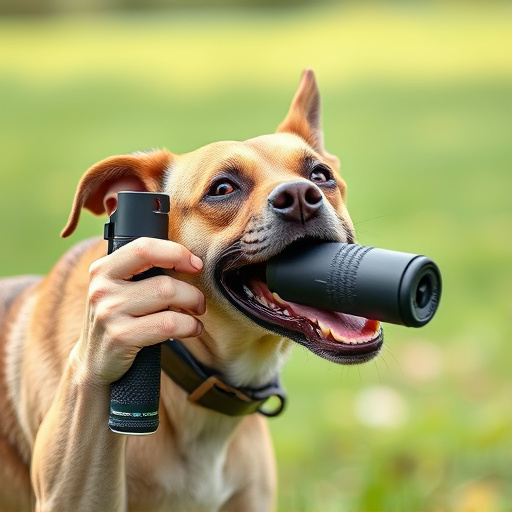Mace dog deterrents, utilizing pepper spray and UV dye technology, offer innovative pet safety solutions, but their legality varies across US states, with different regulations on legal carry of pepper spray for dogs. Understanding these laws is crucial for effective use while adhering to regional rules. Age restrictions and local bans further emphasize the need for thorough research before usage. Regular practice in controlled environments is key to ensuring consistency and enhancing outdoor effectiveness.
Discover the innovative world of dog deterrents with a unique twist—the Mace dog deterrent infused with UV dye. This article explores the intersection of law and technology in the US, delving into the legal perspectives surrounding pepper spray for dogs. We uncover the science behind UV dye, its role in enhancing deterrent efficacy and tracking. Additionally, practical tips on implementation and training ensure effective use. Understand the benefits and considerations when it comes to States Legal Carry Pepper Spray for Dogs.
- Understanding Mace Dog Deterrents: A Legal Perspective on Pepper Spray for Dogs in the US
- The Science Behind UV Dye: Enhancing the Efficacy and Tracking of Dog Deterrents
- Implementing and Training with Mace Dog Deterrents: Tips for Effective Use
Understanding Mace Dog Deterrents: A Legal Perspective on Pepper Spray for Dogs in the US
Mace dog deterrents, which employ pepper spray to scare and repel aggressive dogs, have gained attention as innovative solutions for pet safety. However, their legality varies across the United States, with different states having distinct regulations regarding the legal carry of pepper spray for dogs. This legal perspective is crucial in understanding how these deterrents can be effectively utilized while adhering to regional laws.
In many US states, pepper spray, including that designed for dog deterrence, falls under the category of less-lethal force tools. While some states explicitly permit the use and carry of such sprays for personal protection against dogs, others have more stringent restrictions. For instance, certain states require a doctor’s prescription or specific training certifications to possess pepper spray intended for animal deterrence. Additionally, there might be age restrictions, and in some cases, local authorities may even ban the use of pepper spray on animals altogether. It is essential for dog owners considering this option to research and understand their state’s laws, ensuring they remain within legal boundaries while safeguarding their pets and themselves from potential dog attacks.
The Science Behind UV Dye: Enhancing the Efficacy and Tracking of Dog Deterrents
The Science Behind UV Dye: Revolutionizing Dog Deterrents
In recent years, the use of ultraviolet (UV) dye in dog deterrents has emerged as a groundbreaking innovation. UV dye technology enhances the effectiveness and tracking capabilities of traditional dog deterrent methods, such as pepper spray for dogs. This advanced approach leverages the unique properties of UV light to create a powerful and precise tool for managing canine behavior. When activated by UV light, these dyes emit visible colors that can be easily tracked, providing pet owners and law enforcement with valuable data on the application’s reach and impact.
The legal carry of pepper spray for dogs in various states has sparked debates, but the integration of UV dye offers a more nuanced solution. By combining the irritant effects of pepper spray with the tracking capabilities of UV dye, dog deterrent products become both more efficient and transparent. This scientific advancement not only ensures better control over canine activities but also promotes safety by allowing users to precisely target problem areas and monitor the effectiveness of their chosen deterrents.
Implementing and Training with Mace Dog Deterrents: Tips for Effective Use
Implementing and training with Mace dog deterrents requires a strategic approach for effective use. Start by understanding local laws regarding the legal carry of pepper spray, especially when it comes to dogs, as regulations can vary greatly between states. Ensure you’re using a product specifically designed for canine deterrence, as not all pepper sprays are created equal.
During training, teach your dog an associative response to the mace deterrent—a specific hand signal or verbal command that triggers a brief release of the spray. This should be followed by immediate positive reinforcement, such as treats and praise, to reinforce the behavior. Consistency is key; regular practice in controlled environments will help your dog learn and respond reliably to the deterrent, enhancing its effectiveness when faced with potential threats outdoors.
The integration of UV dye into mace dog deterrents offers a powerful tool for both efficacy and accountability. By understanding the legal framework governing pepper spray for dogs in the US, as well as the scientific advancements behind UV dye technology, pet owners and professionals can leverage these innovative products to enhance safety measures. Implementing and training with mace dog deterrents properly ensures their effective use while adhering to States’ legal requirements on the legal carry of pepper spray for dogs.
